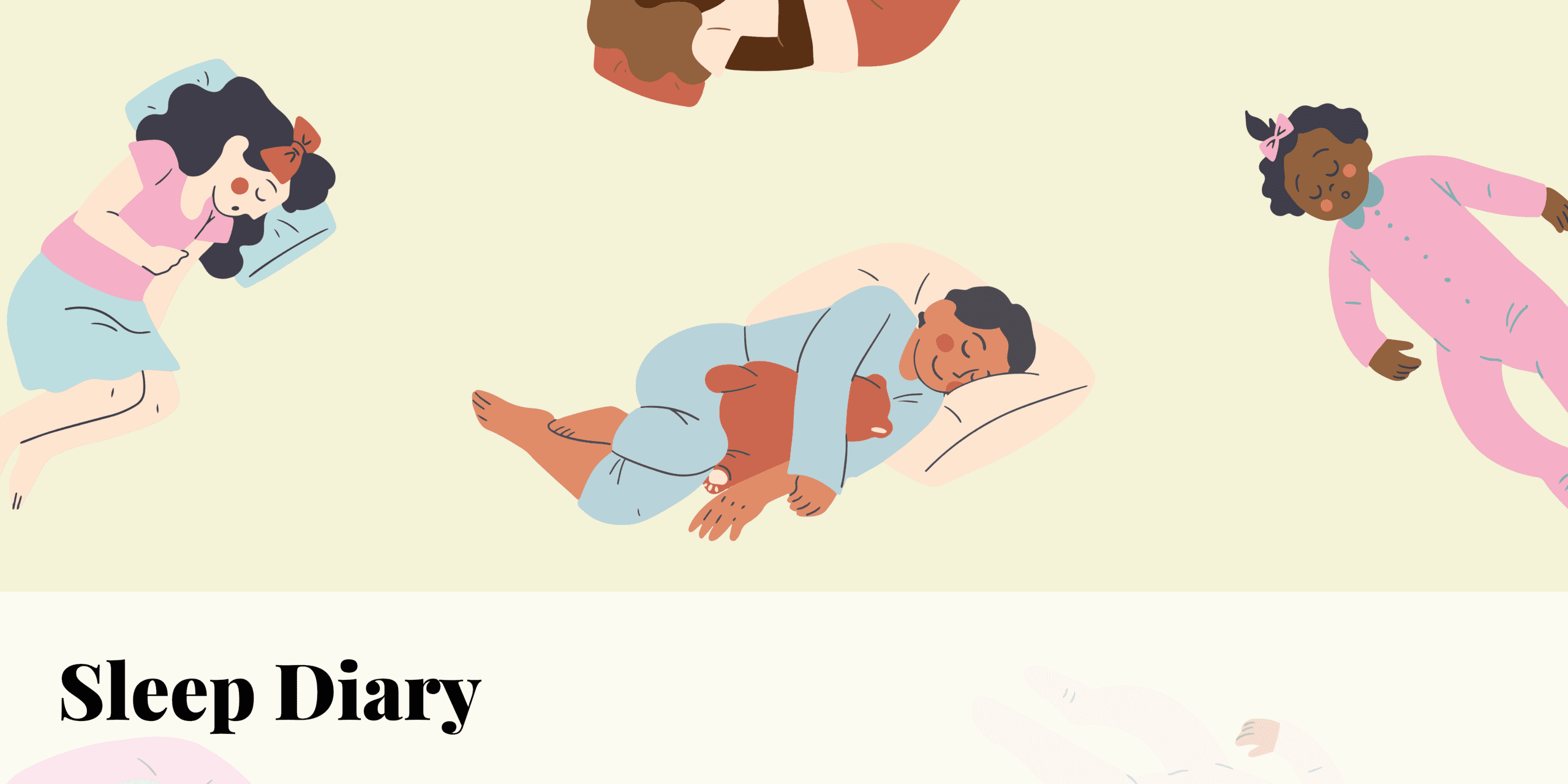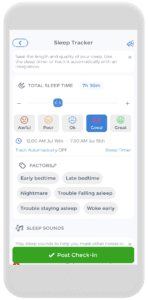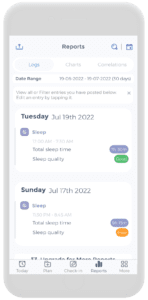
How many times have you caught yourself falling asleep at work? Dosing off while staring at your screen, having trouble focusing on a task you had to complete for your boss at the end of the day. The truth is you just haven’t been sleeping well these past couple of nights, and it’s starting to catch up with you. Poor quality and quantity of sleep can make you feel from drowsy to downright irritable and can be a sign of many underlying issues. This is why many people keep what is known as a sleep diary: a record of their sleep patterns to conclude the quality and quantity of sleep they get each night.
The Importance of Sleep
What is Sleep?
By definition, sleep is the natural state of unconsciousness, in which brain activity is not apparent – we aren’t moving or thinking per se – but is still very much there and detectable1. While it may seem like a period of resting for your body, much more is happening behind the scenes. Many of us may have noticed that a good stretch of sleep can wake us up feeling significantly better after a bout of sickness. Contrastingly, if we were to have remained awake during that period, not much improvement would have been seen.
The Sleep Cycle
The Sleep Cycle consists of four stages:
Stage 1 – You close your eyes, your body relaxes, and it starts to feel like you are floating on a cotton candy cloud. You know the feeling. This stage encompasses when your mental activity is dream-like and fuzzy1.
Stage 2 – The mundane, wandering thoughts.
Stage 3 – At this point, you are in a slightly deeper sleep. Your brain waves have slowed, your muscles have relaxed, and your body temperature and pulse have dropped1.
Stage 4 – Your deepest sleep is the point of no return. At this point, good luck to whoever is attempting to wake you. Following this, you either ascend to stages 2 or 3 once more or move on to REM (rapid eye movement) sleep, where vivid dreaming occurs1.
This cycle of sleep repeats 4 or 5 times a night and the amount of time spent in each stage changes as the night progresses. Generally, REM periods and time spent in stage 2 increase while intervals of time spent in stage 3 decrease1.
The Restorative Nature of Sleep
This is because sleep is restorative1. Our body and nervous system recuperate during this period. Additionally, while hormones involved in the consumption of oxygen and energy are flying high while we are awake, sleep hormones perform the opposite function. Instead, they, along with proteins synthesized while awake, promote the renewal of tissues1.
Symptoms of a Lack of Sleep
Imagine you have just pulled multiple all-nighters to try and get an assignment done for the end of the week. By your third day, you find yourself zoning out while trying to finish up your last couple of sentences. You read back your writing, and it appears jumbled and nonsensical. You find yourself losing your temper with your sister much faster, and when your roommate tosses you the keys, your find yourself reacting slower than normal. One look at the mirror in the morning has you gasping at the wrinkling you see around your eyes, along with the beginning of some very deep dark circles.

A poor attention span, decreased functionality in thinking, mood changes, slow reaction time, premature wrinkling and dark circles are only a few of the symptoms associated with sleep deprivation1,2,3. A good night’s rest can reverse all these symptoms, rebooting your body and helping you to bounce back both emotionally and phsyically2.
It’s always a good idea to keep track of your symptoms to determine if your sleep could be hindering your day-to-day health and activities. The CareClinic Symptom tracker allows you to keep all your symptoms in one place, with the easy and practical organization by date and time. Drawing conclusions by comparing your symptoms to your recorded amount of sleep has never been easier!
The Physical Consequences
More importantly, continuing to go about your daily life without sufficient sleep can put you at risk for a variety of long-term health problems3. Chronic sleep deprivation can cause high blood pressure, diabetes, and cardiac events, including heart attacks, heart failure or stroke. Moreover, a lack of sleep can increase your risk for other potential problems, such as obesity, depression, decreased immune function and lower sex drive3.
How Much Sleep Do You Need?
With all this in mind, you may begin asking yourself how much sleep YOU need. While sufficient sleep is necessary for optimal performance during the day, the amount of sleep each person requires can vary greatly. Generally, we need somewhere around 6 to 9 hours of sleep, based normally on your age4. While the list below is a general guide based on this measurable quantity, it is important to consider other factors, such as gender, familial genetics and daily activities. These factors may have an independent influence over the amount of sleep YOU require4.
Sleep Requirements by Age
In accordance with the recommendations made by the National Sleep Foundation following a 2-year study, the following is the general goal you should aim to reach each night depending on your age bracket3:
- 0 to 3 months: 14 to 17 hours3.
- 4 to 11 months: 12 to 15 hours3.
- 1 to 2 years: 11 to 14 hours3.
- 3 to 5 years: 10 to 13 hours3.
- 6 to 13 years: 9 to 11 hours3.
- 14 to 17 years: 8 to 10 hours3.
- 18 to 25 years: 7 to 9 hours3.
- 26 to 64 years: 7 to 9 hours3.
- 65+ years: 7 to 8 hours3.
Why Keep a Sleep Diary?
While we have briefly touched on the consequences of not getting enough sleep, it’s important to digest the potential disorders a poor quality of sleep may indicate. Staying aware of your individual and personal sleep patterns can keep you one step ahead of these disorders. In fact, some of the most common sleep disorders can be easily identified through a sleep log. This is why sleep tracking is vital to a healthy and vital you!
Obstructive Sleep Apnoea Syndrome (OSAS)
Sleep apnoea is present in approximately 4% of men and 2% in women aged 30 to 60, with a strong association between OSAS and the male gender, increased age and obesity5. Apnoea generally is characterized by 2 categories: nocturnal and daytime symptoms. Nocturnal symptoms are what most people generally think about when they hear the words sleep apnoea: loud snoring, choking while asleep, abnormal motor activities while asleep, and profuse sweating at night.
Daytime symptoms, however, are less known and include sleep attacks lasting anywhere from 30 minutes to 2 hours, forgetfulness, a morning headache and dry mouth upon awakening. The consistent presence of these symptoms throughout your sleep journal may suggest that you have OSAS. Certain factors may influence the presence of these symptoms. Speak to your doctor to learn how best to lessen and eliminate symptoms all together5.
Insomnia and Narcolepsy
Insomnia is the most common sleep disorder, defined as difficulty initiating and maintaining sleep5. This includes early morning awakening and non-restorative sleep occurring more than 3 times a week for longer than a month, coupled with impaired daytime function. While most insomniacs report a marked improvement after identifying a stressful event as the root cause of their insomnia, sometimes, a cause may not be found.
Narcolepsy, on the other hand, is the complete contrast to insomnia as it is defined through the presence of uncontrollable sleep attacks5. These episodes are described as an irresistible and persistent desire to fall asleep in random circumstances. For example, individuals suffering from narcolepsy may spontaneously fall asleep while in conversation, walking, or eating. These spells generally last anywhere from a couple of minutes to half an hour and usually result in the patient feeling refreshed afterward. As with most syndromes, the frequency of these attacks is completely individualized, ranging from multiple times a day to every few months5.
What is Restless Leg Syndrome?
Restless leg syndrome (RLS) is the most common movement disorder found in our general population5. A chronic sensory-motor neurological disorder, RLS prevalence increases with age and is characterized by crawling, tingling, burning, aching, cramping, or itching sensations between the knees and ankles. As a result, an intense urge to move the limbs relieves these sensations in the legs and other parts of the body where they might be experienced, including the arms. These movements, especially in the early stages of RLS, are noted when the patient is resting in bed and has a profound impact on sleep disturbance5.

In general, diagnoses in the hardest part of managing a sleep disorder5. Most disorders are managed with limited consultations in an effective manner5. So, why should you keep a sleep record? The short answer: is to prioritize the wellness of your own body and health.
Overall, whether you call it a sleep diary, sleep log, sleep journal, or sleep tracker chart, having a sleep record of some sort is beneficial. Furthermore, it is important to stay aware of your sleep patterns to catch sleep disorders early. Thus, having a record of your own sleep quality and quantity, as well as your symptoms, can allow you to derive correlations between the 2 by helping identify issues at the earliest stage and halt them. The CareClinic app makes this easy through the chart feature under the reports tab, giving you the tools you need to be the best and most refreshed version of yourself every day!
How to Use a Sleep Diary
Generally, a sleep diary is simply a self-reported daily record of personal sleep-related information7. Resultantly, each person or organization’s sleep diary may vary in what they include details about. However, there are several common features found in a sleep diary, including:
- The time at which to begin attempting to sleep7
- Wake-up time7
- How long does it take to fall asleep7
- Number and duration of sleep interruptions7
- Number and duration of additional naps7
- Perceived sleep quality7
- Consumption of influencing materials such as alcohol, tobacco and/or caffeine7
- Daily medications7
- Daily exercise7
Keeping a sleep journal is quite straightforward: you fill it out carefully and in detail every day, usually in both the morning and evening times7. If there is one thing I want you to take from that instruction, it is these 5 words: fill it out every day! Staying current and updated is important to avoid gaps in your memory, so make sure to keep your diary and pen in a consistent and easily accessible place. The best part of a sleep diary is to decide for yourself how long you want to record your sleep and how often to analyze it7. You’re in complete control.
Commonly Used Sleep Logs
Every sleep log template is different. Each has features that you may absolutely love and find necessary, while others may simply be a repetitive waste of space. Try a few sleeping logs or sleep diary templates to find the right fit for you.
Some of the most well-known Sleep Diary Templates:
National Sleep Foundations Diary
What sets this diary apart are the sections for what time you get out of bed versus actually waking up, how you feel in terms of alertness upon awakening and logging your bedtime routine8.
Sleep Foundation Diary
The Sleep Foundation Diary also includes all the necessary features to qualify it as a sleep log: bedtime, wake-up time, hours spent to sleep, etc. However, it also includes how long it takes you to fall asleep, how many times you woke up during the night, your sleep quality rating and a section dedicated to other factors and general comments7.
AASM Sleep Diary
The sleep diary designed by the American Academy of Sleep Medicine is like most others but has a more chart-like and concise look to it. As compared to a more elaborate journal, like the examples shown above with sections to write comments and personalize them, the AASM log gets straight to the point. For each day, the type of day (work or school for example) indicates along with each hour of the day. In each box, you are asked to provide a notation to indicate is you have consumed any caffeine (C), medicine (M), alcohol (A), exercise (E), when you go to bed (|) and when you fell asleep (shading in the box)9. While this is a stripped-back version of what we have seen so far, at its core, this diary encompasses all the keep features in a simplistic and structured format.
Tracking, Managing and Improving Your Sleep
As our world progresses, more and more traditional face to face of handwritten tasks are becoming digitalized. Especially in the medical and health care community. Take a prime example: EMRs. In the past, electronic medical records were once handwritten on charts and compiled into a folder. As you can probably imagine, this proved incredibly time-consuming and difficult to discern the (notoriously illegible) handwriting of the physicians taking notes. Consequently, human error became a risk, and a lack of copies of the medical records made them incredibly important. Safekeeping of these records also likely took up a lot of space.
The rise of the digital era has solved many of these problems for us. EMRs that were once handwritten have become a software that compiles all patients with each one’s individual and relevant information in one place. As a result, this improves efficiency, time, and space, and error becomes less likely due to the clarity of standardized text font. While these are benefits specific to the example, there are many more advantages to having digital health records available.
Regarding a sleep diary, many of us may not be willing to carry around a notebook when travelling or going about our day. It simply is not convenient. Having your sleep diary easily accessible on your phone allows you to carry it with you wherever you go without limitation. This promotes consistency in maintaining the diary while proving beneficial in terms of time, space, and reduced error. This is why many sleep diaries are now available in the form of sleep diary worksheets/pdf files. Additionally, many health care apps have a sleep diary function that can be adjusted to best fit your needs.
Why a Sleep Log is Beneficial for good Sleep Hygiene
The CareClinic App is the perfect health care app to record your sleep patterns. The sleep log template provided encompasses not only the basic features of total sleep time, quality of sleep and other factors but also has additional features that allow for a thorough record, including a sleep timer and sleep sounds to help analyze how you get the best rest possible. All check-ins are easily accessible under the report logs feature, while patterns are readily recognizable using the sleep tracker chart. Moreover, these features are available in your pocket at the click of a button. It is the perfect companion for you in a dark room (with blackout curtains), a comfortable pillow, and a moderately cooled room.


The CareClinic app makes taking care of your health and sleeps easier than ever. An additional diary function allows you to record any other notes you may want to keep. The app is user-friendly, compact and keeps all your data in one place for efficient correlation analyses. In this way, you can stay in control of your own body and health and make sure you feel the best you can be at every moment of every day!
References
- Fox, M. R. (1999). The importance of sleep. Nursing Standard, 13(24), 44-47. https://www.proquest.com/docview/219801640?fromopenview=true&pq-origsite=gscholar
- Mayo Clinic. (2021, March 2). How a sleep diary can transform how you feel. Healthy Lifestyle Adult Health. Retrieved from: https://www.mayoclinic.org/healthy-lifestyle/adult-health/in-depth/how-a-sleep-diary-can-transform-how-you-feel/art-20342128
- Cleveland Clinic. (2022, March 25). Here’s What Happens When You Don’t Get Enough Sleep (and How Much You Really Need a Night). Health Essentials. Retrieved from: https://health.clevelandclinic.org/happens-body-dont-get-enough-sleep/
- Hor, H., & Tafti, M. (2009). How much sleep do we need?. Science, 325(5942), 825-826. https://doi.org/10.1126/science.1178713
- Chokroverty, S. (2010). Overview of sleep & sleep disorders. The Indian Journal of Medical Research, 131, 126-140. https://doi.org/10.1016/S0030-6665(05)70123-7
- Libman, E., Fichten, C. S., Bailes, S., & Amsel, R. (2000). Sleep Questionnaire Versus Sleep Diary: Which Measure Is Better?. International Journal of Rehabilitation and Health, 5(3), 205-209. https://doi.org/10.1023/A:1012955423123
- Suni, E. (2022, April 12). Sleep Diary. Sleep Foundation. Retrieved from: https://www.sleepfoundation.org/sleep-diary
- National Sleep Foundation. (2021, February 25). NSF Sleep Diary. Sleep and You. Retrieved from: https://www.thensf.org/nsf-sleep-diary/
- American Academy of Sleep Medicine. (2021). Sleep Diary. Sleep Education. Retrieved from: https://sleepeducation.org/resources/sleep-diary/


